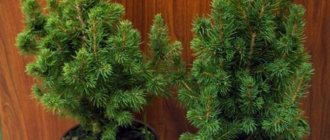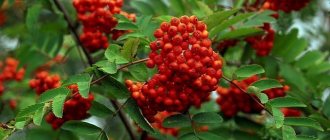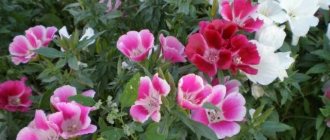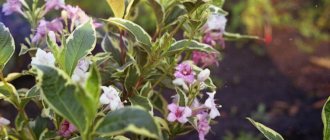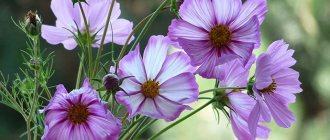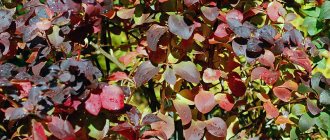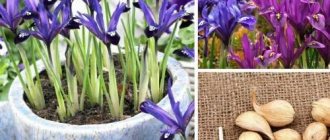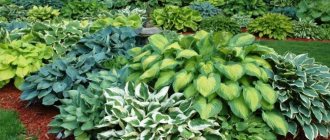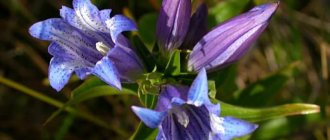Description
Japanese quince is best planted in early spring before buds begin to bloom.
But the autumn planting period also gives good results. The seedling should not be buried when planting. Plants are placed at a distance between rows of 2.5–3 meters, in a row between bushes 0.5–1 meter. For border plantings and hedges, plants are placed more densely. The shrub is planted in a sunny place, but well protected from cold winds, so that a lot of snow accumulates in winter.
Flooded and low areas are absolutely not suitable. Chaenomeles tolerates drought well, and excess water can cause its death. Soils are slightly acidic; on alkaline soils, they are affected by chlorosis. The outstretched arrangement of the branches has a beneficial effect on overwintering. But, in very severe winters, branches located above the level of snow cover may freeze. To preserve flowers, bend the branches to the ground, pressing them with stones. Thanks to the deep, well-developed root system, low quince can be grown without additional watering.
Methods for propagating Japanese quince for transplantation
There are several ways to propagate Japanese quince.
Seeds
Due to the fact that varietal qualities are not preserved during seed propagation, it is used when growing rootstocks with further regrafting.
Seeds collected from fruits in the fall are stored in damp sand at a temperature of about 0°C throughout the winter (thus they undergo stratification).
Seeds are sown in planting containers in February - March, after 1.5 months they are planted in separate containers and at the end of May - beginning of June the seedlings are ready for planting in open ground.
Regular watering and fertilizing are carried out until autumn ; for the winter, seedlings that are not yet fully grown are insulated with fallen leaves.
The easiest way is to immediately plant seeds collected in the fall in prepared rows, sprinkle with soil, cover with polyethylene and cover with leaves.
The germination of such seeds is excellent , since they have undergone natural stratification; in the spring, dense seedlings need to be thinned out, leaving the strongest ones. By autumn, the seedlings are ready to be transplanted to a permanent place of growth.
It is best to collect the seeds in the fall and immediately plant them in the beds, covering them with polyethylene.
Cuttings
In early June, green cuttings are carried out . Annual cuttings with a “heel” (a piece of last year’s wood) are cut. The sections are treated with “Kornevin” for better rooting and planted in a tree at an angle.
To maintain humidity, cover the plantings with plastic film. By autumn, the seedlings are ready to be transplanted to a permanent place, but it is better to do this in the spring.
You can cut mature cuttings in the fall and bury them under the bush at a depth of 20-30 cm, making sure to mark the location.
Over the winter, callus forms at the ends of the cuttings and with the onset of spring, the cuttings are planted immediately in a permanent place.
Dividing the bush
The easiest way to reproduce . Shoots with a well-developed root system are separated from the mother bush (root shoot) and replanted.
Horizontal layering
Quince often grows creeping shoots , which can be dug into seedlings for subsequent propagation.
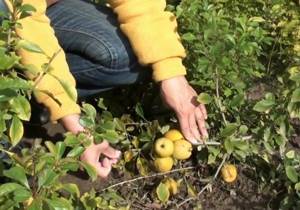
You can bend horizontal layerings of Japanese quince to the ground and bury them
Japanese quince - beneficial properties
In terms of the content of organic acids, Japanese quince occupies one of the first places among fruits and berries (1.5–2 times higher than apples). However, the main value of chaenomeles is its high content of vitamin C (120–180 mg per 100 g), which is 2.5 times more than in lemon. The deficiency of this vitamin is especially noticeable in winter and spring. Then Japanese quince processing products can become its valuable source. In addition, it has been proven that vitamin C protects a person from colds, and also promotes the production of a unique protective substance interferon in the human body. Quince fruits contain P-vitamin compounds, carotene and minerals.
Pectins are natural “evacuators” of radioactive elements, such as isotopes of strontium and cobalt, which are bound by pectins and removed from the human body. Pectins are stabilizers of ascorbic acid (vitamin C) and are a good antidote to heavy metals and other toxic substances, and help remove cholesterol from the body.
Quince in landscape design
The tall shrub looks great in single plantings. In a large garden, you can plant several plants (it is important to maintain the spacing between neighboring bushes). Interesting options for landscape decoration are obtained by combining plantings of Japanese Quince with bright, reddish-orange flowers with Forsythia, which has rich yellow inflorescences. Chaenomeles is the central part of the composition, a “self-sufficient” plant, an ideal decor against the backdrop of green grass and a neatly trimmed lawn.
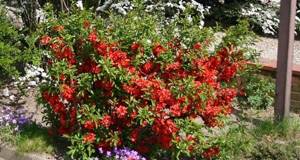
Planting Japanese quince on a site is carried out taking into account the advice given in the article. With proper care and a set of simple measures, the deciduous shrub has been pleasing its owners with spectacular flowering and a harvest of vitamin-rich fruits for decades. Quince with multiple root shoots is an ideal option for planting on slopes that need to be strengthened.
After watching the video, you can find out more useful information about planting Japanese Quince, as well as the rules for caring for a beautiful flowering shrub:
Reproduction of Chaenomeles
Japanese quince can be propagated by seeds and vegetatively, for example, by root suckers, layering, dividing the bush and green cuttings.
Seeds
Japanese quince seeds (Chaenomeles)
The main method of propagation is by seed. The fruits are collected as they ripen; when collected in bulk, unripe fruits ripen and produce viable seeds.
Sowing is carried out in the fall with freshly collected seeds, in the spring - after 3 months of stratification. I sowed some of the seeds in the garden in the fall. I didn’t make it in time for the rest, because the frost hit and the soil froze. Until spring, I buried them in a snowdrift, after putting them in a gauze bag. I will sow in the spring when the soil is ready. I’ll compare the results and draw a conclusion when it’s best to sow Chaenomeles seeds.
The seed sowing rate is 4–5 g. When forming seedlings, if they have poor tillering, pruning is carried out “to the stump” in the 2nd year.
Chaenomeles
In the genus Chaenomeles there are 4 known species growing in China. Japan. As a rule, these are semi-evergreen or deciduous, beautifully flowering shrubs; they have thorns on their branches. Large orange or brick-red single flowers are very impressive. Chaenomeles fruits resemble apples. They hang quite tightly on the branches.
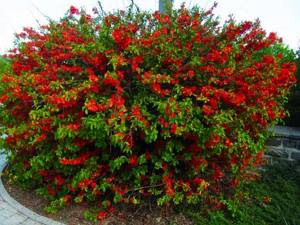
In gardening, shrubs do best growing in open areas. In dry summers, the plant is responsive to watering. With proper care, the shrub can live for about 85 years. Chaenomeles reproduces by seeds (freshly collected in the fall), by dividing the bush, cuttings, and layering.
In Russian gardening, the most widely used are Japanese quince, varieties and hybrids.
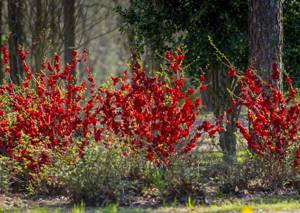
Quince low - wintering in the Moscow region
Since I have been growing Japanese quince in a garden near Moscow for more than 13 years, I came to the conclusion that it is necessary to cover chaenomeles. So that severe frosts in snowless winters do not deprive us of the fruit harvest. Because the branches freeze, and along with them the flower buds that are above the snow level. Therefore, I cover the bushes with spruce branches, dry stems of autumn asters, autumn helenium “Moerheim Beauty” and other tall plants. Then I carefully bend the branches to the ground and cover them with dead wood. It is important that the shelter inside is ventilated so that the bushes do not melt during the thaw. That is, approach the winter shelter of the Japanese quince carefully.
Chaenomeles cathayan
The shrub comes from China, is a little similar to Japanese chaenomeles, and is much less commonly used in landscaping.
Shrub reaching 3 m tall. Blooms in May. The shoots of Chaenomeles catayan are gray-brown. The foliage is lanceolate, purple, brown in spring, green and shiny in summer. The edges of the foliage are serrated.
The flowers have a deep pink color. Blooms annually. The fruits are egg-shaped. Annual shoots of Chaenomeles Catayan in the middle zone can freeze.
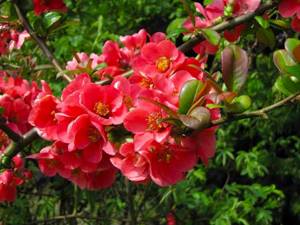
Japanese quince fruit - use
Japanese quince fruits are unsuitable for fresh consumption due to their very sour and hard pulp. However, they serve as an excellent raw material for making jam, jelly, marmalade, marmalade, syrup, compote, marshmallows, marshmallows, lemonade, liqueur and other products. Blending with fresh fruits and vegetables improves the quality of the final product. Japanese quince fruits contain a small amount of sugars, but a lot of pectin substances, which have the property of forming jelly in the presence of sugars and acids.
The fruits of large and medium sizes are of greatest value. They are used to make compotes and jam. Smaller but ripe fruits are used to obtain the extract. Jam, compote and fruit salads made from Japanese quince with pumpkin and apples have good taste and wonderful aroma. Chaenomeles fruits are suitable for making juice, dessert wines and liqueurs, to which they impart a beautiful golden-amber color and persistent aroma. The wine has a wonderful bouquet. The juice, due to its high acid content, can be used in wine blending. You can get strong vinegar from the fruits and pomace.
The taste of Chaenomeles processed products is better if the fruits are blanched for 5 minutes before use. The fruits can be added to tea instead of lemon. They are dried and dried, having previously separated the juice. The remaining product can then be used, for example, to make purees, candied fruits, jam, jam. The juice is blended with the juices of apricot, grape, tangerine, carrot, and celery. Chaenomeles syrup is added to dishes instead of vinegar.
Fresh fruits can be stored for up to 3 months.
Quince is beautiful
An ornamental shrub with thorny shoots and shiny green foliage, which turns red when blooming, then green, and turns purple in autumn.
The beautiful quince blooms in May for about 20 days with large red flowers covering the branches. A light-loving shrub, it grows and blooms well on light soils, but also tolerates poor soils with high acidity.
There are many varieties and forms of beautiful quince with double and simple flowers of different colors, including:
'Boule de Feu' - bright red large flowers;
'Phylis Moore' - pink large flowers;
'Nivalis' - white flowers.
Dish recipes
Compote
The fruits are cut in half or into slices, cleared of seeds, placed in jars, filled with syrup (500 g of sugar per 1 liter of water) and pasteurized.
Raw jam
Raw Japanese quince jam with honey
Clean, chopped quince slices are sprinkled with sugar (1:1), or even better, poured with natural honey, placed in jars, covered with lids and stored in the refrigerator. Served with tea instead of lemon.
Jam
The prepared fruits are cut into slices, dipped in boiling syrup (1 kg of quince, 1.3–1.5 kg of sugar and 1–1.5 glasses of water), then removed from heat for 4–6 hours, then 4–5 times boil for 5 minutes and stand for 10–12 hours.
Candied fruit
The fruits, cleared of seeds, are cut into slices and dipped in boiling syrup (1.3 kg of sugar, 3 glasses of water and 1 kg of quince), the basin is shaken and left for 5–6 hours until completely cooled, then put back on the fire and boiled for 6–6 hours. 7 minutes, and then stand for 10–12 hours. Repeat this procedure 4 times. After the last cooking, the fruits are placed in a sieve or colander to drain the syrup. Candied quince can be boiled with pieces of pumpkin or zucchini.
Marmalade
The fruits are baked in the oven, rubbed through a colander, mixed with sugar (1:1.2) and cooked until the mass reaches for the spoon and lags behind the bottom. Then it is laid out on a dish moistened with water and dried.
Chaenomeles fruit tea
To properly dry Japanese quince fruits, cut them into small pieces.
You can dry it in a way convenient for you. If you put dry pieces of chaenomeles in a jar or paper bag, this will protect them from moisture. When brewing tea, add a teaspoon of dry quince slices to the teapot. The tea will taste sour with an unusual quince aroma. You will definitely like it. Materials used: “Gardener’s Handbook”, All-Russian Research Institute of Plant Growing named after. N. I. Vavilova, 2000, “Decorative dendrology”, Kolesnikov A. I., 1964; “My Garden”, M. Alexandrova; “Trees and shrubs for amateur gardening and landscaping” N. Aksenov, L. Frolov.
Japanese quince - photo and description of the bush. Growing and care
Japanese quince, or chaenomelis as it is also called, has long been known to gardeners in Europe, where it was grown as an ornamental crop for almost two centuries. And only at the beginning of the last century, its valuable fruit qualities were finally recognized.
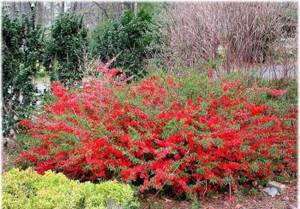
Next, breeders got down to business and developed a number of high-yielding varieties with large fruits and almost no thorny shoots. In total, there are about 500 varieties of Japanese quince, but the vast majority of them have insufficient frost resistance for our region, and therefore are not grown in Russia.
Japanese quince: description of the bush
Japanese quince is a small (up to 1 meter) deciduous or semi-evergreen shrub. The homeland of Chaenomelis is Japan, China, Korea. The shrub has arched shoots with glossy leaves, and the species and many hybrid forms also have thorns on the shoots.
Japanese quince flowers are large, up to 5 cm, very beautiful red-orange in color, but there are also varieties with white and pink flowers, and even double ones. Quince blooms very profusely and for a long time in May-June.
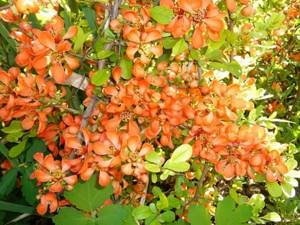
Fruiting occurs in 3-4 years; quince fruits ripen in the middle zone in September-October. They are shaped like an apple or pear with colors ranging from yellow-green to bright orange.
Japanese quince: cultivation and care
Chaenomeles has a long tap root, therefore it is a drought-resistant plant, but this circumstance interferes with replanting: chaenomeles is almost impossible to replant without damaging the root. Quince is undemanding to soils - it can grow in poor soils. However, rich humus soils - loose and moderately acidic and moist - are accepted with a bang, that is, they bloom and bear fruit profusely. But Japanese quince does not tolerate saline and calcareous soils at all. And quince is sensitive to light, so it needs to be planted in well-lit areas, otherwise you won’t get a good harvest.
Japanese quince is planted both in spring and autumn. For planting, holes are dug 50 cm deep and 60 cm wide, which are filled with compost or humus with the addition of ash and complex mineral fertilizer. The seedling is buried in the soil to the level at which it grew in the nursery, after which the quince is watered abundantly, and the ground around the bush is mulched. It should be remembered that Japanese quince is cross-pollinated, so to obtain good harvests, you need to plant at least three seedlings on the site. The distances between bushes are maintained at 1 - 1.5 m.
Caring for Japanese quince is not difficult, since quince is an unpretentious shrub. It is necessary to regularly loosen the soil in tree trunk circles in spring and autumn and weed out weeds. Since quince is drought-resistant, it needs to be watered rarely and in cases of prolonged absence of rainfall.
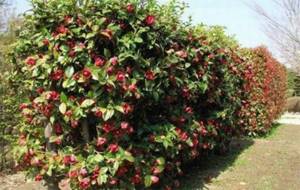
Japanese quince needs fertilizing with fertilizers. Root feeding is carried out twice - before flowering and during the initial formation of fruits. For the first feeding, take 1 tbsp per 10 liters of water. a spoonful of urea and 2 tbsp. spoons of any complex fertilizer. The second feeding can be done in combination: for 10 liters of water, 2 tbsp. spoons of organic matter and 1 tbsp. spoon of complex fertilizer.
In the spring, the quince crown is formed by pruning. Pruning is carried out as early as possible, cutting out all branches older than 5 years. A properly formed quince bush should have no more than 12-15 branches.

Japanese quince is harvested before frost sets in, removing both ripe and unripe fruits. After three months of storing fruits at a temperature reduced to 3-5 degrees, their taste improves.
For the winter, it is advisable to bend the quince branches and pin them to the ground, despite the fact that the shrub is considered frost-resistant. Quince branches sprinkled with snow will survive the winter better in severe frosts.
Planting Chaenomeles
A plant with an open root system is planted at the end of March or in mid-autumn so that the bush has time to adapt to new conditions and take root well. Container bushes can be planted with a clod of soil at any time. Two to three year old specimens take root best.
Make sure that when planting, the root collar does not go deep into the soil, but remains at ground level. If you plant several varieties at once, the distance between them will depend on the maximum growth of the bush. Large specimens are usually planted at a distance of 1.5 meters from each other.
During planting, immediately add nutrients to the soil: two parts of peat, 100 g of superphosphate, 400 g of ash, part of sand and a couple of kilograms of humus. Young seedlings require regular watering at first. In dry summers, it is recommended to mulch the soil, as mulch prevents moisture evaporation and controls the growth of weeds.
Read on the topic: Mulching function and types of mulches
Features of caring for Chaenomeles
All species are tolerant of almost any type of substrate, provided there is good drainage. But flowering will be most abundant when chaenomeles is planted in fertile, calcium-rich soil with a slightly acidic or neutral pH. Chaenomeles will not grow on heavy, swampy soils. In alkaline soil, the plant develops chlorosis - yellowing and discoloration of the leaves.
The culture prefers sunny, warm places protected from the wind, since during winter some of the shoots may freeze. You can also grow quince in partial shade, but then the flowering will not be so abundant, which will affect fruiting.
The shrub is resistant to drought, and due to its weak root system it suffers from waterlogging and weeds, so when caring for chaenomeles, it is useful to carry out regular weeding and watering 1-2 times a month. In rainy summers, the plant suffers from excess moisture and can be affected by fungal diseases. Almost all varieties of crops are winter-hardy, some of them can freeze only in very severe frosts in the absence of snow.
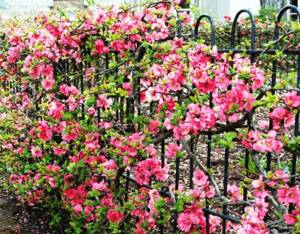
Variety "Pink Lady"
How to plant Chaenomeles Japanese quince? Rules of care
Have you ever seen a Japanese quince? This is a rather unusual plant because it has an arched, slanted shape, a bushy form, bright flowers and fragrant fruits. Such a tree will not only be an excellent decoration for your summer cottage, but will also give you an abundant harvest of beautiful fruits. Its main advantage is resistance to frost, cold and drafts. The topic of this article is Chaenomeles Japanese quince - planting and care. From it you will learn how to choose the right seedling, where and when to plant it.
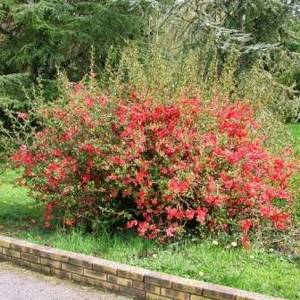
Chaenomeles quince japonica
